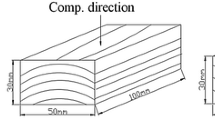Abstract
In this study, the Chinese fir (Cunninghamia lanceolata Hook.) specimens with different ratios of heartwood thickness to sapwood thickness (HS) were radially compressed at different compression speeds, and then absorbed amine copper quat-type D (ACQ-D) preservative solution under the negative-pressure produced by the recovery of compression deformation. The liquid uptake (A l), the recovery rate of compression deformation (R s) and the chemical absorption (A c) of samples were determined, as well as the overall distribution of density and effective component of ACQ-D (i.e., copper in wood), the mechanical properties such as surface hardness were also measured. The A l, R s, A c values of compressed samples including the whole heartwood ones were higher than those of uncompressed samples, showing that radial compression had an obvious positive effect on improving the liquid absorption of heartwood. Higher compression speed of 3 mm·min−1 is preferable since the samples with that speed could reach the highest A l and A c; in addition, more deformation fixation has been produced possibly because of the faster heat and moisture transmission at the higher compressed speed, and more bonds of hydrophobic nature were formed, leading to the higher surface hardness and density. A consistent tendency of the density distribution and the copper retentions along the thickness direction could be explained that the layers with higher density have smaller volumes of void areas, and more chemicals were absorbed and fixed, resulting in the higher copper retentions.
Similar content being viewed by others
References
Cobham P, Vinden P. 1995. The use of pressure cycling to improve heartwood penetration in Pinus radiata (D. Don). The 26th Annual Meeting of International Research Group on Wood Preservative. Helsinger, Denmark
Cooper P A. 1973. Effect of species, precompression, and seasoning on heartwood preservative treatability of six western conifers. For Prod J, 23(7): 51–59
Higashihara T, Morooka T, Hirosawa S, Norimoto M. 2004. Relationship between changes in chemical components and permanent fixation of compressed wood by steaming or heating. J Jpn Wood Res Soc, 50(3): 159–167
Iida I, Ikeuchi A, Imamura Y. 1995. Liquid penetration of precompressed wood III: effects of moisture contents of specimens and ambient temperatures while compression on liquid uptakes of softwoods and hardwoods. J Jpn Wood Res Soc, 41(9): 811–819
Iida I, Imamura Y. 1995. Liquid penetration of precompressed wood IV: mechanical properties of set-fixed wood before and after recovery. J Jpn Wood Res Soc, 41(12): 1165–1172
Iida I, Mori S, Nakamura Y, Sakai H, Imamura Y. 1996. Liquid penetration of precompressed wood, 5: Effects of cyclic loading, type of impregnated chemicals and annual ring angles on the uptake of water or oily solvents. J Jpn Wood Res Soc, 42(6): 581–588
Iida I, Yusuf S, Watanabe U, Imamura Y. 2002. Liquid penetration of precompressed wood VII: combined treatment of precompression and extraction in hot water on the liquid penetration of wood. J Wood Sci, 48(1): 81–85
Iida I. 1992. Liquid penetration of precompressed wood, 1: effects of compressive deformation and recovery upon liquid uptake. J Jpn Wood Res Soc, 38(3): 233–240
Sanders M G, Amburgey T L, Barnes H M. 2000. Innovations in the treatment of southern pine heartwood. The 31th Annual Meeting of International Research Group on Wood Preservative. Kona, Hawaii.
Shams I, Yano H. 2004. Compressive deformation of wood impregnated with low molecular weight phenol formaldehyde (PF) resin II: effects of processing parameters. J Wood Sci, 50(4): 343–350
Tang X S, Zhao G J, Tetsuya N. 2004. Changes of chemical composition and crystalline of compressed Chinese fir wood in heating fixation. For Stud China, 6(4): 39–44
Unsal O, Candan Z. 2008. Moisture content, vertical density profile and janka hardness of thermally compressed pine wood panels as a function of press pressure and temperature. Drying Technol, 26: 1165–1169
Watanabe U, Imamura Y, Iida I. 1998. Liquid penetration of precompressed wood VI: Anatomical characterization of pit fractures. J Wood Sci, 44(2): 158–162
Author information
Authors and Affiliations
Corresponding author
Rights and permissions
About this article
Cite this article
Mao, J., Cao, Jz. & Zheng, X. Effect of compression on the liquid absorption of Chinese fir wood with different heartwood-to-sapwood ratios. For. Stud. China 11, 196–201 (2009). https://doi.org/10.1007/s11632-009-0030-5
Received:
Accepted:
Published:
Issue Date:
DOI: https://doi.org/10.1007/s11632-009-0030-5




